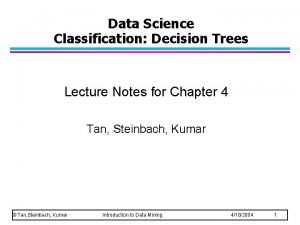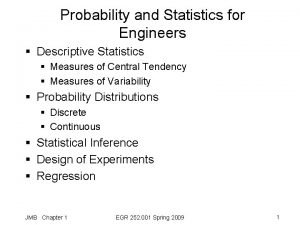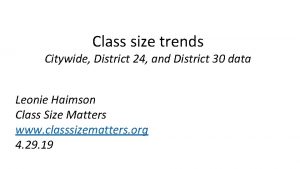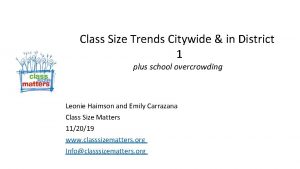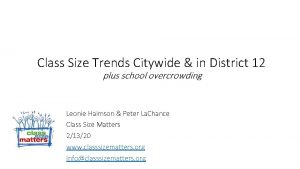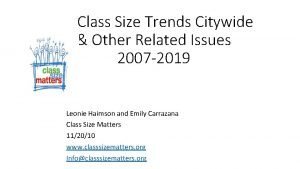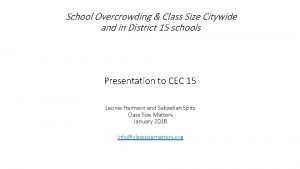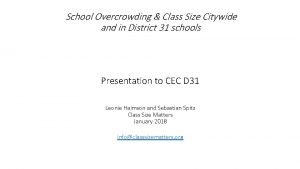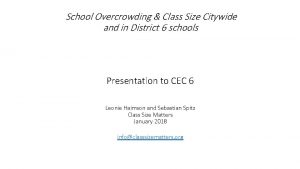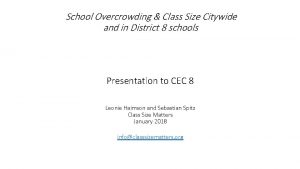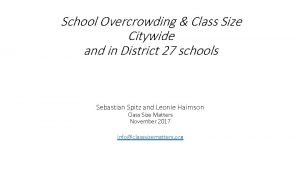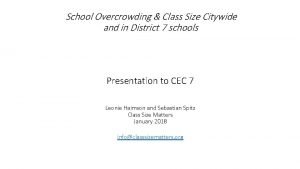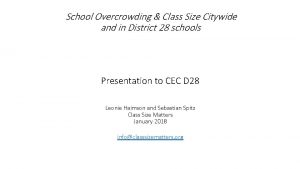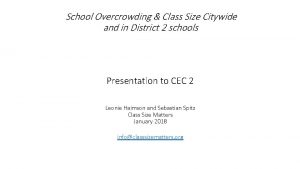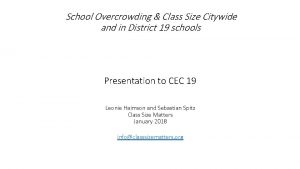Class Size Trends Citywide District 13 and District

















- Slides: 17

Class Size Trends Citywide, District 13, and District 17 data Leonie Haimson Class Size Matters www. classsizematters. org 5. 22. 19

Smaller classes have been linked to better student outcomes in every way that can be measured • Better grades, better test scores, more engaged and less likely be disruptive when they’re provided with smaller classes. • Students randomly assigned to smaller classes are more likely to graduate from HS in 4 years, go onto college, get a STEM degree, own their own home and have a 401 K 3 more than 20 years later. • Most importantly, small classes are one of only a handful of reforms that narrows the achievement gap between economic & racial groups and thus are essential for true equity in the NYC public schools.

D 13 K-3 average class size grew by 0. 8 this year while D 17 average class size remain the same. Both districts are still above 2007 and C 4 E levels. 23, 9 20, 8 20, 7 18, 9 2007 -8 21, 4 20, 5 19, 6 2008 -9 22, 1 22, 0 20, 3 19, 9 2009 -10 22, 9 22, 7 23, 3 24, 5 24, 1 22, 7 21, 8 21, 2 24, 9 24, 7 23, 9 24, 6 22, 5 22, 8 23, 0 22, 5 24, 2 22, 7 22, 6 24, 0 22, 2 21, 7 23, 9 22, 5 22, 2 20, 1 19, 9 19, 9 2010 -11 2011 -12 2012 -13 2013 -14 2014 -15 2015 -16 2016 -17 2017 -18 2018 -19 C 4 E Goals Citywide actual D 13 D 17

Grades 4 -8 th average class size in D 17 increased by 0. 5. Both D 13 and D 17 remain above C 4 E levels. 25, 1 25, 3 24, 8 24, 6 23, 7 23, 8 21, 1 21, 2 2007 -8 2008 -9 25, 8 24, 9 23, 8 23, 3 2009 -10 26, 3 25, 3 26, 6 25, 7 2010 -11 26, 8 26, 7 23, 7 22, 9 2011 -12 C 4 E Goals 26, 7 26, 6 26 25, 0 23, 3 26, 7 22, 9 2012 -13 24, 7 24, 0 22, 9 2013 -14 Citywide actual 23, 9 23, 0 22, 9 24, 8 23, 7 23, 3 22, 9 2016 -17 2017 -18 2018 -19 22, 5 2014 -15 D 13 24, 0 D 17 2015 -16

NYC class sizes are 15 -30% higher on average than classes in rest of state 30, 0 25, 0 19, 0 20, 0 24, 8 23, 9 23, 3 24, 8 20, 3 19, 7 22, 1 21, 5 20, 9 26, 5 25, 8 26, 1 25, 6 24, 9 23, 6 22, 4 20, 6 26, 8 20, 6 20, 5 15, 0 10, 0 5, 0 data source: NYSED for 2016 -2017; http: //www. p 12. nysed. gov/irs/pmf/ ry ist m Ch e gli sh En 11 HS rest of state 9 7 M at h 7 En gli sh gr 6 t h gr 5 t h gr 4 t h gr 3 r d gr d 2 n gr 1 s t NYC En Ki n de rg a rte n 0, 0

D 13 average class sizes 9 -52% higher than state averages D 17 average class sizes 6 -28% higher than state averages 31, 3 28, 5 26, 1 23, 2 20, 720, 9 19, 7 19, 0 Kindergarten 22, 5 1 st gr 23, 3 20, 3 22, 0 2 nd gr 23, 123, 2 20, 9 3 rd gr 24, 0 23, 3 21, 5 23, 4 23, 3 22, 1 4 th gr 5 th gr rest of state 23, 8 22, 4 23, 8 24, 1 20, 6 6 th gr D 13 English 7 D 17 24, 7 29, 1 26, 5 24, 9 23, 4 20, 6 Math 7 21, 8 20, 6 English 9 20, 5 English 11 20, 6 HS Chemistry

What these class size averages do not show • There are extreme disparities in class size across NYC neighborhoods and districts, with many students in classes of 30 or more. • The number of students in very large classes has grown sharply since 2007 especially in K 3.

Citywide at least 336, 165 students are in very large classes of 30 or more in fall 2018 (14% of K-3 students, 36% of 4 th-8 th gr students & 57% of all HS students) 336 165 182 425 115 903 37 837 K-3 Grade 4 -8 High School (Minimum) Total

In D 13 and D 17, 11, 682 and 4, 474 students were in very large class sizes 30 or more in fall 2018 10467 2693 555 660 grades K-3 grades 4 -8 D 13 345 HS (min) grades K-3 1436 grades 4 -8 D 17 HS (min)

Percent of students in classes 30 or more in fall 2018. 72% 56% 33% 13% 20% 17% 14% 7% D 13 D 17 grades K-3 grades 4 -8 Citywide HS (min)

The number of Kindergarten students in classes of 25 or more citywide has increased by more than 53% (5, 893 students) since 2007 17 067 11 174 2007 2018

The number of Kindergarten students in classes of 25 or more in D 13 and D 17 has increased by more than 1420% and 81% respectively since 2007 380 280 155 +1420 +81 25 2007 2018 D 13 2007 2018 D 17

Number of 1 st - 3 rd graders in classes of 30 or more has grown by nearly 3000% citywide 36 486 1 185 2007 2018

Number of 1 st - 3 rd graders in classes of 30 or more in D 13 and D 17 has grown by 1, 750% and 271% respectively. 555 345 +1, 750 93 +271% 30 2007 2018 D 13 2007 2018 D 17

Number of 4 th-8 th graders in classes of 30 or more has grown by 40% citywide 115 903 83 055 2007 2018

Number of 4 th-8 th graders in classes of 30 or more in D 13 and D 17 has grown by 63% and 59% respectively 1436 902 660 406 +59% +63% 2007 2018 D 13 2007 2018 D 17

What should we do? • We are advocating that $100 M in next year’s city budget be allocated specifically towards reducing class size, starting first in the early grades and at struggling schools. This is less than 1% of total DOE budget. • That would allow the hiring of 1, 000 new teachers, which could lower class size in as many as 4, 000 classrooms – as adding a new teacher at a grade level lowers class size for other students in that same grade. • We also need an accelerated capital plan. Right now 50, 000 of the 57, 000 seats in the new five-year capital plan aren’t proposed to be finished until 2024 or later.
 Citywide
Citywide How to find class boundaries
How to find class boundaries Market share formula
Market share formula Ionization energy trend periodic table
Ionization energy trend periodic table Char char slide
Char char slide Which mechanism help in size separation by sieve shaker
Which mechanism help in size separation by sieve shaker Decision tree example of car type, shirt size and class
Decision tree example of car type, shirt size and class What is the size of the class interval?
What is the size of the class interval? Quartile deviation formula
Quartile deviation formula My home district kishoreganj paragraph for class 5
My home district kishoreganj paragraph for class 5 Difference between abstract class and concrete class
Difference between abstract class and concrete class Abstract concrete class relationship
Abstract concrete class relationship Therapeutic class and pharmacologic class
Therapeutic class and pharmacologic class Static vs dynamic class loading
Static vs dynamic class loading Current and future trends in media
Current and future trends in media What about today's class
What about today's class Putting a package together
Putting a package together Measures of central tendency for grouped data
Measures of central tendency for grouped data






